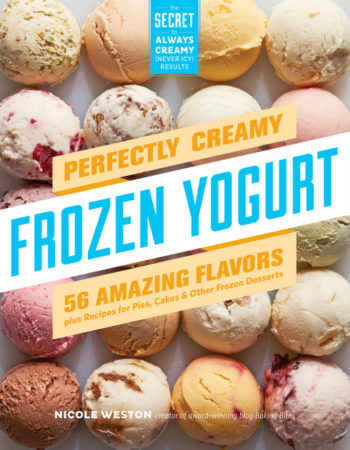Your most basic peanut butter contains just peanuts and some oil to help the peanuts blend together into a smooth paste. There are two distinct types of peanut butter: “regular” and “natural”. “Regular” is the term I’ll use to define your standard peanut butter and jelly sandwich peanut butter, and a category that includes most easy to find national brands. It’s creamy and thick, even at room temperature, and usually has salt and sugar in addition to peanuts in the recipe. “Natural” peanut butter is much thinner than regular peanut butter at room temperature, and tends to be extra firm when chilled. It rarely has extra ingredients added to it and it separates easily into the oil and peanuts used to make the butter.
When it comes to baking, I tend to use what is on hand, but there will often be some differences in recipes made with natural peanut butter instead of regular. Most recipes (unless otherwise specified) are written with the assumption that you’ll use regular peanut butter. The salt and sugar from that regular peanut butter can add a lot of flavor to a recipe, and the thickness of the peanut butter translates into less spread for peanut butter cookies, for instance. Natural peanut butter is often unsalted, so you may need to add additional salt to a recipe. It might also seem saltier than regular peanut butter because of the lack of sugar in the mix, so you might want to cut back on the salt in the recipe by 1/4 tsp if you are very sensitive to it. Natural peanut butter cookies tend to spread out more, and frequently have a crispier texture (this is often do to a higher proportion of oil in the mix) than cookies made with regular peanut butter. Since they spread out more, they sometimes need a slightly shorter baking time.
Most recipes will deliver a similar result no matter which type of peanut butter you use – even if you do have to make a tiny tweak or two due to a lack of salt or sugar in your product – so you can still use whatever is on hand. But watch out for a recipe that specifically calls for one or the other and be aware of the slight differences that exist between the two types.
Now, there are a few types of low fat, low carb or reduced something-or-other peanut butters out there as well (other types of nut butter work the same way as natural peanut butters). If you’re going to use these in baking, check the ingredients list first. The more that it differs from standard peanut butter, the greater the chance that you’re going to have some differences in taste and texture in your finished recipe. That isn’t to say that whatever you’ve made won’t still be tasty. It just might not be the same as using your standard peanut butter, so keep that in mind when tasting the results.




Sheila
March 19, 2009I looove natural peanut butter. Mix it with a little bit of honey and dip some apples into it…oh, heaven!
This is random, but I saw these homemade poptarts and thought you might be interested!
http://asweetfantasy.blogspot.com/2008/01/pop-tarts.html
Nick
March 19, 2009Good info, but there is a major difference between even natural peanut butter brands. For example, Trader Joe’s creamy natural peanut butter is about as runny as oil (but much tastier) while Koeze Cream-Nut, Teddie or even PB&Co creamy natural peanut butters are much thicker. I would say that as long as the consistency of a natural peanut butter isn’t too runny, you shouldn’t run into problems. Natural PB is much more useful in peanut sauce or scones, it’s much easier to spread around and mix with a spoon or by hand.
The real question is, how can I incorporate peanut butter into ALL my baked goods? How much butter or oil can it replace?
Also, I advise everyone to avoid the low-fat and low-carb peanut butter. The difference in calories is negligible and they’re actually less healthy, peanut butter is healthy to begin with!
Nicole
March 20, 2009Nick – I think that the answer to your question is simple experimentation. Peanut butter can’t always be a straight substitute for butter and oil because it has much less fat (veg oil is all fat, while peanut butter has a lot of solid peanut material). It can work in some recipes as an addition or as a way to cut down on the oil or butter, of course, but I think the best way to work out those recipes is to play around with the amounts until you achieve a texture and flavor that works for you!
Cooking Lady
March 21, 2009It’s funny you should post about this. We are, in fact, converting this household form processed foods to more natural substitutes…peanut butter being one of those items.
Thanks for the tips.
Maria
March 21, 2009This might be my first comment, though I’ve been reading for quite some time now. First, I must say that every recipe I’ve used from your site has turned out great! (I especially like the mini macaroons!)
But I’ve got to comment that none of the “natural” peanut butter I buy has any oil added to it. The layer of oil you see on top has just separated from the ground peanuts. I used to buy some from Whole Foods that I ground myself! I think, in fact, that added oil (usually partially hydrogenized) is one of the main components of processed (fake) peanut butter.
Sadly, I can’t really eat peanut butter now, since my fiance is deathly allergic to them. But at least I can get my fill vicariously. Haha!
Grandma Judi
April 4, 2009I reply for Maria and suggest with a heavy blender I make
my own nut butters from other nuts. I especially like to add
coconut oil to some drier nuts. I make a sunflower seed butter and use it in my recipe for peanut-butter roll. For Interesting healthy recipes look at my website
Wheat-freeandmorefree.com.
KonstantinMiller
July 6, 2009I have been looking looking around for this kind of information. Will you post some more in future? I’ll be grateful if you will.
Sherri S
December 6, 2009I have baked the Oatmeal Peanut Butter Chocalate Chip cookies using both types of peanut butter, natural and commercial. The cookies turned out much better using commercial. I was surprised that when I switched to natural the cookies didn’t taste as peanut-buttery (is that a word?). Alos, as the author swuggests, the cookies made with natural peanut butter didn’t hold up as well, tjhey flattened out and got crispy on the edges. So there is my two cents. 🙂
Barb
September 5, 2010Made peanut butter banana bread yesterday from a recipe specifying “do not use natural peanut butter”. Well, as that was all I had on hand, I did anyway. The results were superb! I ran out of sugar, so 1/3 of what was called for in the recipe was light brown sugar and I substituted half the flour with whole-wheat flour. Best banana bread I ever made. If you only have natural peanut butter, give it a try – it worked fine for me.
Amy
July 18, 2012I just made Oatmeal Peanut Butter Chocolate Chip cookies as well and I agree with Sherri. The natural peanut butter made it not only harder to work with, but the taste didn’t seem as great as the regular or commercial peanut butter. Both the ending result of the natural peanut butter and regular peanut butter went well, but I would recommend using regular or commercial peanut butter when making Oatmeal Peanut Butter Chocolate Chip cookies. My main reason in recommending the regular is that when I was making the cookie dough(with the natural peanut butter), it was much too dry and not sticky enough compared with the cookie dough I had made previously with the regular peanut butter, so I had trouble spooning the cookie dough on the cookie sheets and resorted into using my hands because it just couldn’t stay together.
Short story: when making oatmeal peanut butter chocolate chip cookies, don’t use natural peanut butter.